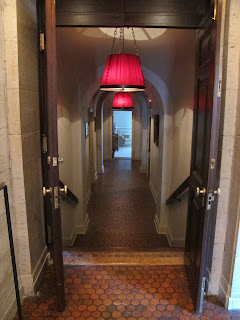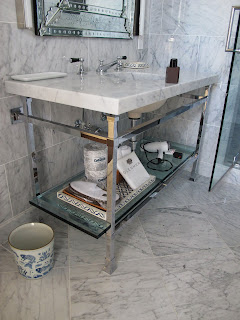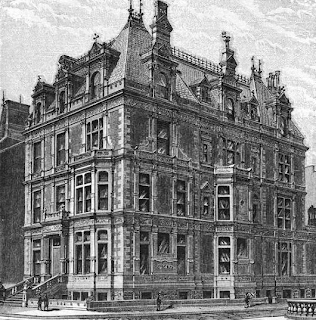Wednesday, November 14, 2012
A Better Fate Than Many
Glenmere, the house behind these gates, was supposedly built by a doting husband for a wife who wanted to live in an Italian villa. Almost as soon as it was finished she sued him for divorce on grounds of mental cruelty.
The house was designed in 1911 by the famous firm of Carrere and Hastings for Robert Wilson Goelet (1881-1966), not to be confused with his cousin, Robert Walton Goelet (1880-1941). The name, by the way, is properly pronounced "g'LET." According to "Heard in Club Corners" in The New York Times of October 25, 1903, Robert Wilson - "Bobby" to friends and family - had "adopted something of the English stoop in walking, which is considered very smart, and which is a special characteristic of his future brother-in-law, the Duke of Roxburghe." Titled Englishmen were a feature of the Goelet family, a clan whose enormous wealth in Manhattan real estate made them popular items in the transatlantic marriage bazaar.
In 1904, Bobby Goelet married Elsie Whelan, daughter of Philadelphia socialite banker Henry Whelan. Goelet was not so special to the Whelans; Elsie's sister was married to Craig Biddle, grandson of Anthony Drexel. The appropriateness of the Goelet-Whelan nuptials soothed the soul of Bobby's widowed mother, Mrs. Ogden (May) Goelet (1855-1929) of New York and Newport. Mrs. Goelet's famous cottage, Ochre Court, remains today a vivid symbol of her once vast social power. May Goelet was a daughter of R. T. Wilson, a rumored war profiteer who settled in New York after the Civil War. Wilson famously married all five of his children either to English noblemen or male and female scions of great American families, the latter including Ogden Goelet, Cornelius Vanderbilt Jr. and the daughter of "the" Mrs. Astor. According to a joke of the period, as soon as the last of his children got married the only thing left for Wilson was to murder his wife and marry Queen Victoria. That's me by the front door, thinking social thoughts.
Carrere and Hastings' Glenmere is a junior version of a very similar house the firm had just completed for Colonel Oliver Hazard Payne in West Park, N.Y. - http://newyorksocialdiary.com/node/1907985. Payne's house was twice as big, built with steel and limestone instead of block and stucco, and fitted out with rare marbles and luxurious paneling instead of Glenmere's plain plaster and painted woodwork. Both houses are on the wrong (meaning unfashionable) side of the Hudson. Payne was an abrasive character who didn't care what society thought; Goelet was so highly placed he didn't have to.
Junior version or no, Glenmere is a beautiful place. I hesitate to still call it "old" without noting that it has been totally gutted, then put back together as a facsimile of the original. Nowadays, Glenmere operates as a posh "Relais et Chateaux" hideaway catering to well-heeled New Yorkers searching for a swanky country weekend. It matters not to them that the house is located outside Chester, NY, a pleasant enough Orange County village with not a single other house on the same scale anywhere nearby. The first view below looks from just inside the front door towards that inevitable feature of the Italian villa, the open central courtyard.
The library is one of three main floor rooms facing the view - in this case, Glenmere Lake - just as the Payne house faces the Hudson. Here there's a terrace outside; at West Park there's a columned porch. The library looks like Palm Beach to me, not the Hudson Valley, which is no accident since the man who designed the new interiors is a Palm Beach designer named Scott Snyder. I doubt Goelet would recognize the place, but he's not the one making weekend reservations.
Here's how the big drawing room looked when the present owners came in 2007. It's a fine big room with marble fireplaces at both ends and rows of french doors opening onto the terrace on one side and the courtyard on the other. If the first Mrs. G. didn't get much use out of Glenmere, her former husband surely did. When not at work in the family business he ran with a fast crowd that included a bogus Russian prince named Nicholas Riabouchinsky and his enchanting Italian wife, Fernanda. The couple kept a suite at the Knickerbocker Hotel, until they were kicked out for not paying the bill. Mme Riabouchinsky was forced at first to take a demeaning job as a $35/week chorus girl. She abruptly quit and resurfaced shortly after in a soigne little apartment at 499 Park Avenue, as the constant companion of Robert Goelet.
Here's the drawing room today, also looking very Palm Beach. To return to Bobby and Fernanda, the day came when Prince Riabouchinsky was disposed of - supposedly divorced, assuming he was actually married - and Fernanda married Bobby. In 1921, she gave birth to a baby boy.
This door looks from the drawing room to the courtyard.
This one opens onto the terrace. Let's step outside and continue our story.
Bobby's mother was angry about his divorce, but apoplectic over his dalliance with the so-called "Princess" Riabouchinsky, whom she considered with some justification to be be an adventuress. Once the baby was born, Goelet decided to bring matters to a head by planning a Newport season. Bad idea. "Was Ever a Young Wife Treated Like This?" clucked the Wilmington, DE "Morning Star" of October 30, 1921. The writer's initial tone of saddened sympathy becomes gradually more smug as he demolishes Fernanda's made-up past and relishes her ostracism by Newport's elite. Not one of the great hostesses invited the Goelets to anything. Bobby's mother actually left town rather than meet her new daughter-in-law or grandchild.
Ironically, May Goelet's sister Grace had been considered a climber by the Vanderbilts when she set her sights on Cornelius Vanderbilt Jr. Young Vanderbilt's churchy stick of a father actually disinherited him when he married Grace anyway. This history was seemingly forgotten when May's son married a woman May didn't like. Admittedly, there were differences between Grace Wilson and Fernanda Riabouchinsky. However, if Bobby had been my kid I doubt I would have left the country rather than meet his wife and child.
Here's a view taking during the restoration - rather, rebuilding - which gives an idea of just how extensive the project was.
We're back in the drawing room, looking towards the dining room, which is the third principal room on the main floor.
The dining room, before and after. Goodby Hudson Valley; hello Palm Beach.
Glenmere's makeover included a fair amount of new construction, including the room below. Until I focused on its subtly contemporary feel, I thought it was the original breakfast room. Despite all the changes attendant on conversion to a hotel, Glenmere could easily return to use as a private house.
In many minds, the lure of the Italian villa is its interior courtyard. In the first image below, the front door is behind me and the drawing room is to the right.
Back inside, on the opposite side of the front door from the library, is what I assume was a reception room. It's now the hotel bar. Originally called Frog's End Tavern - I don't know if they still call it that or not - the name commemorated a battle with the Dept. of Environmental Conservation over the fate of northern cricket frogs endangered (supposedly) during Glenmere's reconstruction.
Outside the bar a short stair leads to several ground floor hotel rooms.
The northern flank of the house, behind the outside stairway you saw in the courtyard, has been reconfigured into the hotel office, reception area and a meeting room. Having the hotel's business areas tucked away like this enhances the sense of visiting a private house. Everything back here is new.
The hall below leads to a spectacular formal garden at whose northern end is the swimming pool.
Glenmere has an elaborate spa housed in a new building to the east of the formal garden. Not part of an old house, so not part of my column.
The celebrated designer of high class gardens, Beatrix Jones Farrand (1872-1959) did indeed design a garden at Glenmere. However, as you can see below, this garden is completely new. A kitchen court and servants' entrance were originally on this side of the house.
Back inside, I made tracks to the kitchen, which is new but filled with unexpectedly appealing repro details.
Retracing my steps up from the kitchen, I peeked around the reception area, peered down stairs to the basement (where everything is ultra-new), and finally made my way back to the main staircase.
Perhaps not quite up to Col. Payne's standards, but still quite good looking.
Long bedroom corridors on the second floor wrap around three sides of the central courtyard. A four-room master suite - now divided into a pair of two-room suites - occupies the building's entire southern flank.
The guestrooms are all gorgeous, and all pretty much the same.
They all have decorative fireplaces, with horns...
...and gorgeous marble bathrooms, which even I admit are almost as good as the grand old ones I'm always photographing.
The guestrooms below, originally parts of the master suite, are a good place to pick up the tale of Robert Goelet's marital adventures. In September of 1925, the Pittsburgh Press - and probably a number of other syndicated papers - ran a full page spread titled "The Romance of Exclusive Newport's 'Village Girl' and the $50,000,000 Son of the Social Autocrat Who Has Never Forgiven Him for Losing Wife No.1." Today's society columns, whatever else they may or may not be, don't wallow in the sort of patronizing superiority of this particular piece. The "village girl" was Roberta Willard, a Newport townie who'd known Bobby all his life. Although never in his set, she was a friend and confidante. Lo and behold, as soon as the fake princess demanded a divorce, Bobby asked Roberta to be Wife No 3.
Glenmere was built with his-and-her master bedrooms, but I'm betting Bobby and Roberta slept together. At Glenmere they raised pedigreed dogs, hosted famous shooting parties, and invited fancy guests like the Duke and Duchess of Windsor and Babe Ruth, though probably not on the same weekend. I'd like to think May Goelet patched it up with her errant son - she had only a few more years to live - and was kind to his new wife.
Speaking of kindness, I hope everyone gets one of these.
There is a third floor on the northern flank of the house, with bedrooms, a large salon and a terrace overlooking the interior courtyard. Interestingly, servants' rooms were originally on the second floor, adjacent - and probably once cleverly connected - to those back stairs leading to the basement.
The view of the new garden is quite good from up here.
So what happened to Beatrix Farrand? Her garden at Glenmere, as you can see in the vintage image below, was your basic millionaire's country estate formal garden executed with taste, erudition and panache. Unfortunately, it's fallen very low.
In 1880, Bobby's father Ogden and his Uncle Robert hired a now forgotten architect named Edward Hale Kendall (1842-1901) to build a pair of brick and brownstone mansions across the street from one another at 589 and 608 Fifth Avenue. That's 608 in the image below, located on the southwest corner of 49th and Fifth. It was May Goelet's Manhattan home at the time of her death in 1929.
Seeing the future rising across 49th Street in the form of Rockefeller Center, Robert Wilson Goelet razed his mother's house and commissioned Victor L. S. Hafner to design the Goelet Building. This snappy but oft-overlooked example of urban Art Moderne was completed in 1932. The other Robert Goelet, Bobby's cousin Robert Walton, continued to live in his father's house across the street at 589 Fifth until his death in 1941. The papers noted that 589 Fifth was by then one of only five private houses remaining on Fifth Avenue south of 59th Street.
Robert Wilson Goelet sold Glenmere in the early 1940s to a man named Abraham Prusoff, who ran it as a hotel until Orange County seized it for unpaid taxes. A real estate speculator named Rick Mandel bought it at a tax auction in 1985. The present owners rescued it in 2007. It's a very romantic place to stay; the link is www.glenmeremansion.com.
Subscribe to:
Post Comments (Atom)


























































































I was hoping for a tidbit about the way snow was removed from the courtyard by Carrere and Hastings, the concern of an earlier post abut a house with a similar courtyard.
ReplyDeleteBeautiful place, and reminds me of a lot of the houses in Beverly Hills and environs where I grew up.
ReplyDelete